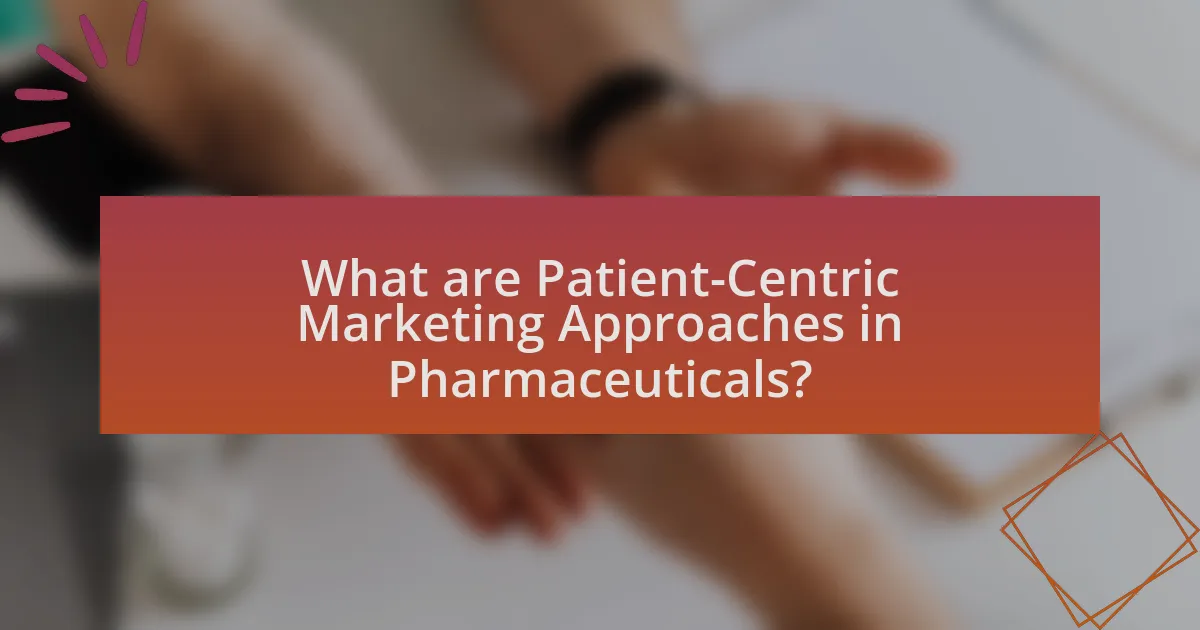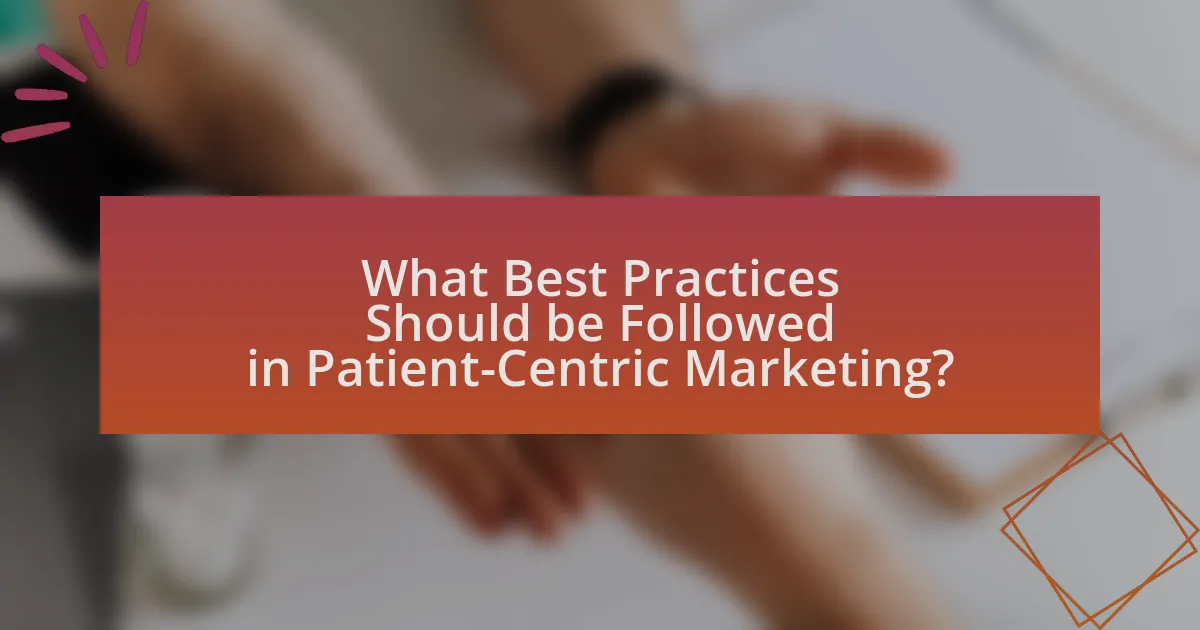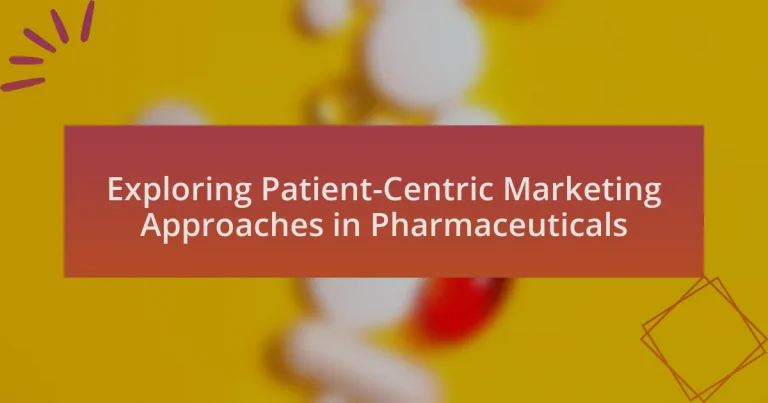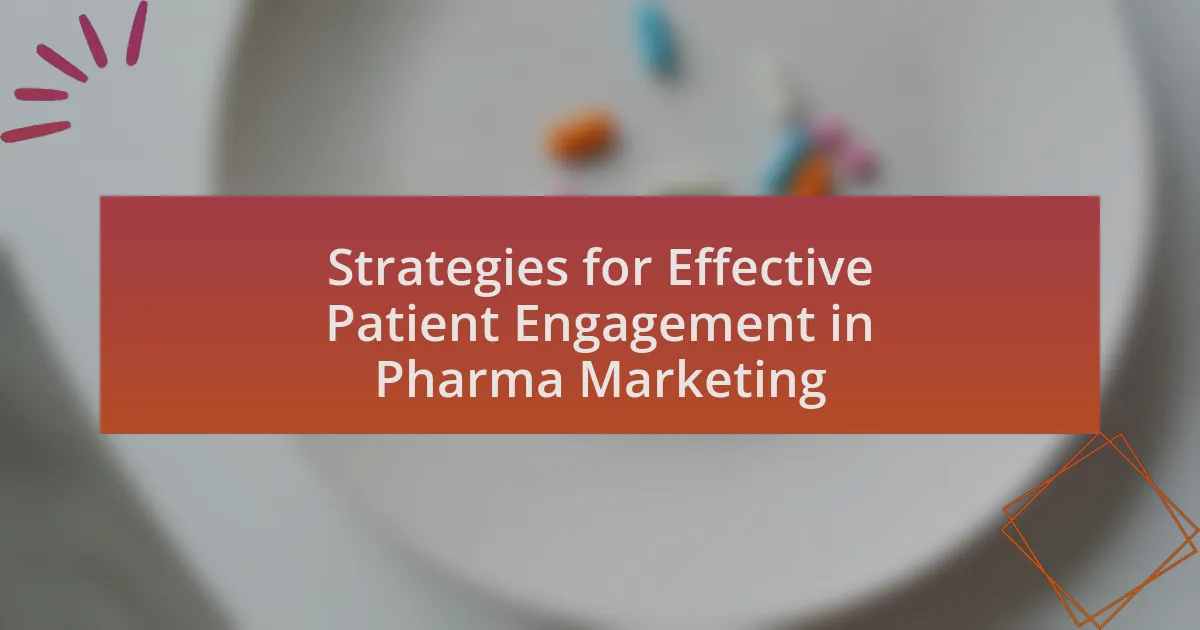Patient-centric marketing approaches in pharmaceuticals prioritize understanding and addressing the needs, preferences, and experiences of patients throughout their healthcare journey. This article explores how these strategies differ from traditional marketing by focusing on patient engagement and personalized communication, leading to improved adherence and satisfaction. Key principles include transparency, data analytics, and fostering engagement, while technology plays a significant role in enhancing patient interactions. The article also discusses the importance of patient-centricity in drug development, the challenges faced in implementation, and best practices for effective patient engagement, highlighting future trends and the impact of social media on patient communication.
What are Patient-Centric Marketing Approaches in Pharmaceuticals?

Patient-centric marketing approaches in pharmaceuticals focus on understanding and addressing the needs, preferences, and experiences of patients throughout their healthcare journey. These strategies prioritize patient engagement, utilizing data-driven insights to tailor communications and services that resonate with patients, ultimately enhancing their treatment experience. For instance, a study published in the Journal of Medical Marketing highlights that 70% of patients prefer personalized communication from pharmaceutical companies, indicating the effectiveness of such approaches in fostering trust and adherence to treatment.
How do these approaches differ from traditional marketing strategies?
Patient-centric marketing approaches in pharmaceuticals differ from traditional marketing strategies by prioritizing the needs and preferences of patients over the product-centric focus of traditional methods. Traditional marketing often emphasizes the features and benefits of a product, targeting healthcare professionals and institutions, whereas patient-centric approaches engage patients directly, utilizing insights from their experiences to shape marketing efforts. For instance, a study published in the Journal of Medical Marketing highlights that patient-centric strategies can lead to improved patient adherence and satisfaction, demonstrating their effectiveness in fostering stronger relationships between patients and pharmaceutical companies.
What are the key principles of patient-centric marketing?
The key principles of patient-centric marketing include understanding patient needs, fostering engagement, providing personalized communication, and ensuring transparency. Understanding patient needs involves gathering insights through research and feedback to tailor marketing strategies effectively. Fostering engagement means creating interactive platforms that encourage patient participation and dialogue. Providing personalized communication ensures that messages resonate with individual patients, enhancing their experience and satisfaction. Ensuring transparency builds trust by openly sharing information about products, services, and potential risks. These principles are supported by studies indicating that patient-centric approaches lead to improved health outcomes and increased patient loyalty in the pharmaceutical industry.
Why is patient engagement crucial in pharmaceutical marketing?
Patient engagement is crucial in pharmaceutical marketing because it enhances the effectiveness of communication and fosters trust between patients and healthcare providers. Engaged patients are more likely to adhere to treatment plans, which can lead to improved health outcomes and increased satisfaction with the pharmaceutical products. Research indicates that companies with high levels of patient engagement can see a 20% increase in adherence rates, ultimately driving better market performance and brand loyalty.
What role does technology play in patient-centric marketing?
Technology plays a crucial role in patient-centric marketing by enabling personalized communication and engagement strategies. Through data analytics, healthcare organizations can gather insights on patient preferences and behaviors, allowing for tailored marketing messages that resonate with individual needs. For instance, the use of customer relationship management (CRM) systems helps track patient interactions, facilitating targeted outreach that improves patient experience and satisfaction. Additionally, digital platforms such as social media and mobile applications provide channels for real-time communication, fostering a sense of community and support among patients. According to a study by Accenture, 77% of patients expressed interest in using digital tools for managing their health, highlighting the effectiveness of technology in enhancing patient engagement and adherence to treatment plans.
How can digital tools enhance patient communication?
Digital tools enhance patient communication by facilitating real-time interactions and providing accessible health information. These tools, such as telemedicine platforms and mobile health applications, allow patients to communicate with healthcare providers instantly, reducing barriers to access. For instance, a study published in the Journal of Medical Internet Research found that telehealth services improved patient satisfaction and engagement by 80%, demonstrating the effectiveness of digital communication in healthcare settings. Additionally, digital tools enable personalized communication through tailored messaging and reminders, which can lead to better adherence to treatment plans and improved health outcomes.
What are the benefits of using data analytics in understanding patient needs?
Using data analytics to understand patient needs enhances personalized care, improves treatment outcomes, and optimizes resource allocation. By analyzing patient data, healthcare providers can identify trends and preferences, allowing for tailored interventions that meet individual patient requirements. For instance, a study published in the Journal of Medical Internet Research found that data-driven insights led to a 20% increase in patient satisfaction scores when healthcare services were customized based on analytics. This demonstrates that leveraging data analytics not only aligns healthcare services with patient expectations but also fosters a more efficient healthcare system.
Why is Patient-Centricity Important in the Pharmaceutical Industry?

Patient-centricity is important in the pharmaceutical industry because it enhances drug development and improves patient outcomes. By focusing on the needs, preferences, and experiences of patients, pharmaceutical companies can create more effective therapies that align with real-world patient experiences. Research indicates that patient-centric approaches can lead to increased adherence to treatment regimens, as evidenced by a study published in the Journal of Managed Care & Specialty Pharmacy, which found that patient engagement strategies improved medication adherence rates by up to 30%. This alignment not only fosters trust and loyalty among patients but also drives innovation and efficiency in drug development processes.
How does patient-centricity impact drug development and approval processes?
Patient-centricity significantly enhances drug development and approval processes by ensuring that the needs and preferences of patients are prioritized throughout the entire lifecycle of a drug. This approach leads to more relevant clinical trial designs, as patient input can inform endpoints that matter most to them, ultimately increasing the likelihood of regulatory approval. For instance, the FDA has emphasized the importance of incorporating patient perspectives in drug development, as seen in their Patient-Focused Drug Development initiative, which aims to gather patient experiences and preferences to guide regulatory decisions. By aligning drug development with patient needs, pharmaceutical companies can improve patient recruitment, retention in trials, and overall satisfaction, which are critical factors in successful drug approval.
What are the implications of patient feedback on clinical trials?
Patient feedback significantly influences clinical trials by enhancing trial design, improving patient recruitment, and increasing retention rates. Incorporating patient insights allows researchers to tailor protocols that align with patient needs and preferences, leading to more relevant outcomes. For instance, studies have shown that trials designed with patient input can achieve higher enrollment rates, as patients feel their voices are valued, which can lead to a more diverse participant pool. Additionally, feedback can identify potential barriers to participation, enabling sponsors to address these issues proactively. This approach not only fosters trust between patients and researchers but also enhances the overall quality and applicability of trial results, ultimately benefiting drug development and patient care.
How can patient-centricity improve health outcomes?
Patient-centricity can improve health outcomes by enhancing patient engagement and adherence to treatment plans. When healthcare providers prioritize the needs, preferences, and values of patients, it fosters a collaborative environment that encourages patients to take an active role in their care. Research indicates that engaged patients are more likely to follow prescribed treatments, leading to better management of chronic conditions and overall health improvements. For instance, a study published in the Journal of Medical Internet Research found that patient engagement strategies, such as personalized communication and shared decision-making, significantly increased adherence rates, resulting in improved clinical outcomes.
What are the challenges faced in implementing patient-centric marketing?
Implementing patient-centric marketing faces several challenges, including data privacy concerns, resource allocation, and the need for cross-functional collaboration. Data privacy regulations, such as HIPAA in the United States, restrict how patient information can be used, complicating efforts to personalize marketing strategies. Additionally, pharmaceutical companies often struggle with allocating sufficient resources to develop and maintain patient-centric initiatives, which can lead to inconsistent messaging and engagement. Furthermore, effective patient-centric marketing requires collaboration across various departments, including marketing, sales, and regulatory affairs, which can be hindered by organizational silos and differing priorities. These challenges collectively impede the successful implementation of patient-centric marketing strategies in the pharmaceutical industry.
How can pharmaceutical companies overcome resistance to change?
Pharmaceutical companies can overcome resistance to change by fostering a culture of innovation and collaboration. This involves engaging employees at all levels in the change process, providing training and resources to facilitate adaptation, and clearly communicating the benefits of the changes to both staff and patients. Research indicates that organizations that prioritize employee involvement in decision-making processes experience a 30% higher success rate in implementing change initiatives. By actively involving stakeholders and addressing their concerns, pharmaceutical companies can reduce resistance and enhance acceptance of new patient-centric marketing approaches.
What are the ethical considerations in patient-centric marketing?
Ethical considerations in patient-centric marketing include ensuring informed consent, maintaining patient privacy, and avoiding misleading claims. Informed consent requires that patients understand the marketing messages and their implications, which fosters trust and transparency. Maintaining patient privacy is crucial, as the use of personal health information must comply with regulations like HIPAA in the United States, safeguarding sensitive data from unauthorized access. Additionally, avoiding misleading claims is essential to prevent exploitation of vulnerable patients; accurate representation of products and services is necessary to uphold ethical standards in healthcare marketing. These considerations are vital for building a responsible and trustworthy relationship between pharmaceutical companies and patients.
What Best Practices Should be Followed in Patient-Centric Marketing?

Best practices in patient-centric marketing include understanding patient needs, utilizing data analytics, and fostering transparent communication. Understanding patient needs involves conducting thorough research to identify their preferences and pain points, which can enhance engagement and satisfaction. Utilizing data analytics allows pharmaceutical companies to tailor marketing strategies based on patient demographics and behaviors, leading to more effective outreach. Transparent communication builds trust, ensuring that patients receive clear and accurate information about products and services. These practices are supported by studies showing that patient engagement can lead to improved health outcomes and increased loyalty to brands.
How can pharmaceutical companies effectively engage patients?
Pharmaceutical companies can effectively engage patients by utilizing personalized communication strategies that address individual needs and preferences. This approach includes leveraging data analytics to understand patient demographics, treatment histories, and feedback, allowing companies to tailor their messaging and outreach efforts. For instance, a study published in the Journal of Medical Marketing found that personalized communication can increase patient adherence to medication by up to 30%. Additionally, incorporating digital platforms, such as mobile apps and social media, facilitates direct interaction and provides patients with valuable information and support, enhancing their overall experience and satisfaction with treatment.
What strategies can be employed to personalize marketing efforts?
Personalized marketing efforts can be effectively employed through strategies such as data-driven segmentation, tailored content creation, and customer journey mapping. Data-driven segmentation involves analyzing patient demographics, behaviors, and preferences to create targeted marketing campaigns that resonate with specific groups. Tailored content creation ensures that marketing messages are relevant and engaging, addressing the unique needs and concerns of individual patients. Customer journey mapping allows marketers to understand the various touchpoints patients encounter, enabling the delivery of personalized experiences at each stage of their healthcare journey. These strategies enhance engagement and improve patient outcomes by fostering a deeper connection between pharmaceutical brands and their audiences.
How can companies measure the success of patient-centric initiatives?
Companies can measure the success of patient-centric initiatives through metrics such as patient satisfaction scores, adherence rates, and health outcomes. Patient satisfaction scores can be gathered through surveys that assess the quality of care and the overall patient experience, providing direct feedback on the effectiveness of initiatives. Adherence rates indicate how well patients follow prescribed treatments, which can reflect the clarity and support provided by the initiatives. Additionally, tracking health outcomes, such as improvements in disease management or reductions in hospital readmissions, offers concrete evidence of the initiatives’ impact on patient health. These metrics collectively provide a comprehensive view of the effectiveness of patient-centric strategies in the pharmaceutical sector.
What are the future trends in patient-centric marketing approaches?
Future trends in patient-centric marketing approaches include increased personalization through data analytics, enhanced digital engagement via telehealth platforms, and a focus on patient education and empowerment. Personalization is driven by the ability to analyze patient data, allowing pharmaceutical companies to tailor their messaging and offerings to individual needs, which has been shown to improve patient adherence and satisfaction. Digital engagement is expanding as telehealth becomes more prevalent, enabling direct communication between patients and healthcare providers, thus fostering a more interactive relationship. Additionally, there is a growing emphasis on patient education, as informed patients are more likely to engage in their treatment plans, leading to better health outcomes. These trends reflect a shift towards a more holistic understanding of patient needs and preferences in the pharmaceutical industry.
How will advancements in technology shape patient interactions?
Advancements in technology will significantly enhance patient interactions by facilitating more personalized and efficient communication. Telehealth platforms, for instance, allow patients to consult healthcare providers remotely, improving access to care and reducing wait times. According to a report by McKinsey & Company, telehealth usage has stabilized at levels 38 times higher than before the pandemic, indicating a strong shift towards digital interactions. Additionally, mobile health applications enable patients to track their health metrics and communicate with providers in real-time, fostering a more engaged and informed patient base. This shift towards technology-driven interactions not only improves patient satisfaction but also enhances adherence to treatment plans, as evidenced by studies showing that patients using digital tools are more likely to follow prescribed regimens.
What role will social media play in future patient engagement strategies?
Social media will play a crucial role in future patient engagement strategies by facilitating direct communication between healthcare providers and patients. This platform allows for real-time interaction, enabling patients to access information, share experiences, and receive support from both peers and professionals. According to a study published in the Journal of Medical Internet Research, 60% of patients reported that social media positively influenced their healthcare decisions, highlighting its effectiveness in enhancing patient engagement. Furthermore, social media can be leveraged for targeted health campaigns, improving awareness and adherence to treatment plans, thus reinforcing its significance in patient-centric marketing approaches within the pharmaceutical industry.
What practical tips can pharmaceutical companies implement for effective patient-centric marketing?
Pharmaceutical companies can implement several practical tips for effective patient-centric marketing, including utilizing data analytics to understand patient needs, engaging in direct communication through multiple channels, and fostering partnerships with healthcare providers. Data analytics allows companies to tailor their marketing strategies based on patient demographics and preferences, enhancing relevance and engagement. Direct communication, such as personalized emails or social media interactions, helps build trust and encourages patient feedback. Collaborating with healthcare providers ensures that marketing messages are aligned with clinical practices and patient care, ultimately improving patient outcomes and satisfaction.




